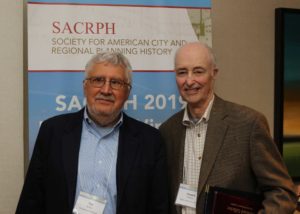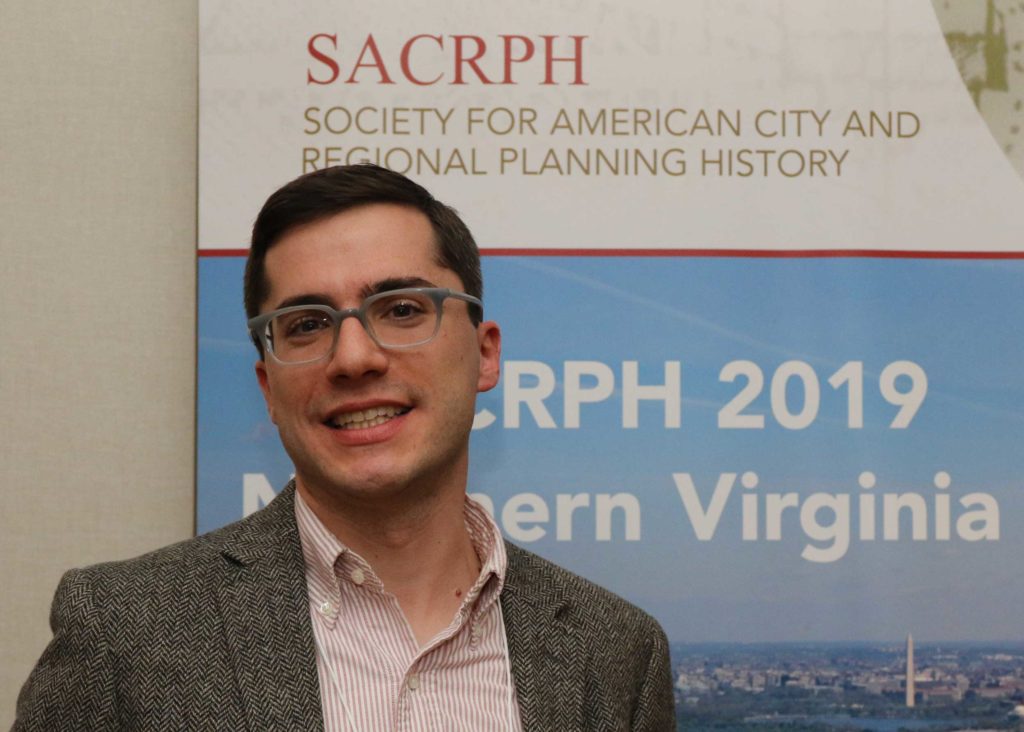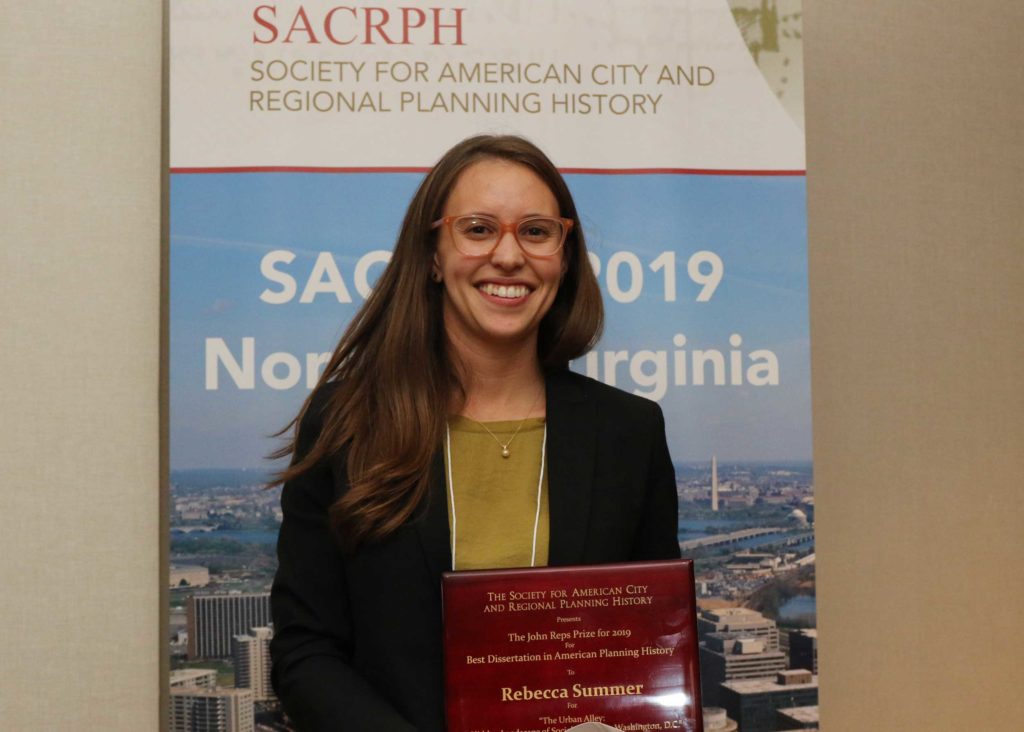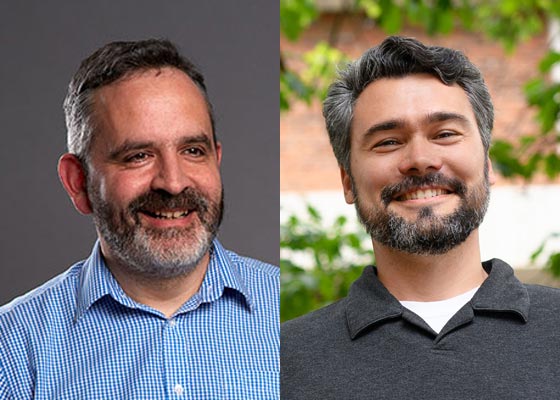2019 SACRPH Award Winners
SACRPH announced its 2019 award recipients at the 18th National Conference on Planning History, held in Arlington, Virginia, from October 31 – November 3, 2019. Congratulations to all our prize winners and thank you to the prize committees who spent considerable time selecting them.
Laurence Gerckens Prize for teaching excellence and leadership
Lewis Mumford Prize for best book
Catherine Bauer Wurster Prize for best article
John Reps Prize for best dissertation
Journal of Planning History Prize for best article in the JPH
Student Paper Prize for best paper at SACRPH 2019
Laurence Gerckens Prize (past winners)
Awarded to a scholar-teacher who has demonstrated sustained teaching excellence and educational leadership in the field of planning history.
Committee members: Alison Isenberg, Princeton University; Robert Fairbanks, University of Texas-Arlington; Robert Freestone, University of New South Wales
Co-Winners:
[expand title=”Howard Gillette, Rutgers University-Camden”] Howard Gillette is Professor of History Emeritus at Rutgers University-Camden. A ‘middle Atlantic’ historian, his books on Camden and Washington D.C. have provided important insights to once neglected cities. He has engaged in many important public history activities and played a key role in the Encyclopedia of Philadelphia. He has served as President of SACRPH and hosted the conference in Philadelphia and Camden. Howard has influenced several generations of students. He has been an unfailing and ongoing mentor to many younger scholars and has created opportunities for others through research and civic engagement activities displaying a strong commitment to community history. Letters from former students, academic and professional colleagues are powerful examples of his long-term impact. We thank these individuals for their engagement in the process and acknowledge Domenic Vitiello in submitting the nomination.[/expand] [expand title=”Edward K. Muller, University of Pittsburgh”]Howard Gillette is Professor of History Emeritus at Rutgers University-Camden. A ‘middle Atlantic’ historian, his books on Camden and Washington D.C. have provided important insights to once neglected cities. He has engaged in many important public history activities and played a key role in the Encyclopedia of Philadelphia. He has served as President of SACRPH and hosted the conference in Philadelphia and Camden. Howard has influenced several generations of students. He has been an unfailing and ongoing mentor to many younger scholars and has created opportunities for others through research and civic engagement activities displaying a strong commitment to community history. Letters from former students, academic and professional colleagues are powerful examples of his long-term impact. We thank these individuals for their engagement in the process and acknowledge Domenic Vitiello in submitting the nomination.[/expand]
Lewis Mumford Prize (past winners)
Awarded to the best book on American city and regional planning history published between August 1, 2017 and July 31, 2019.
Committee members: Louise Dyble, Barnes & Thornburg; Owen Gutfreund, Hunter College; Greg Hise, University of Nevada, Las Vegas
Winner:
[expand title=”Brian Goldstein, Swarthmore College”] Brian D. Goldstein, Swarthmore College, The Roots of Urban Renaissance: Gentrification and the Struggle over Harlem (Harvard University Press, 2017).In The Roots of Urban Renaissance: Gentrification and the Struggle Over Harlem, Brian Goldstein examines the transformation of planning and redevelopment in Harlem over a half-century. Goldstein traces the ways in which Harlemites capitalized on federal and municipal programs to facilitate private investment and captured both to strengthen local institutional structures and to foster self-determination. The causal arrows that link elected and appointed officials with local institutions, NGOs, and citizen planners are drawn in all directions. Goldstein’s analysis of Harlem reveals this dynamic while subtly reminding readers that metropolitan governance has relied on inter-sectoral cooperation for a century. By recognizing the significance of decision-making processes and institutional structures at the neighborhood level, Goldstein is able to trace the ways in which residents engaged and translated city, state and federal policies, actively shaping the transformation of Harlem.
But, this is not a book about just Harlem or New York. Goldstein tells a story that resonates in central city neighborhoods throughout the United States, and he tells this story at different scales. At the local level, he tells us of radical demands for democracy and community self-determination that were at first manifest in protests, occupations, and homesteading, and later gave way to pragmatic embraces of private ownership, retail development, and directed efforts to reinstate a black middle-class. At the federal level, he brings in the policy shifts towards block grants and then enterprise zones. Goldstein integrates these parallel and interconnected changes by emphasizing the agency of contested (and often exclusive) coalitions of local leaders, as they navigate a changing multiscalar political and economic context.
Goldstein’s Harlem is dynamic and varied; there is no unitary grass-roots community, or singular vision for the future. As a result, culpability for ambiguous outcomes, including gentrification and the potential loss of the neighborhood’s black majority today, is equally complex: “the story of gentrification cannot be told only from the point of view of migrants into neighborhoods like Harlem, nor can it be told through simplistic binaries of good and evil or innocence and guilt. Harlem helped to produce this urban renaissance from the grass roots.”
“The Roots of Urban Renaissance” is an important addition to a growing literature on the processes and outcomes of redevelopment in postwar cities. It highlights the social and political implications of broad local engagement. Goldstein’s book is also an exemplar for nuanced research, tackling complex and politically-charged institutions and issues without losing sight of the specificity of Harlem, as a community and a place. In doing so, Brian Goldstein has contributed significantly to our understanding of the transformations of central city neighborhoods in the postwar period.
[/expand]

Catherine Bauer Wurster Prize (past winners)
Awarded to the best scholarly article on American city and regional planning history in any journal, published between August 1, 2017 and July 31, 2019.
Committee members: Janet Bednarek, University of Dayton; Meredith Drake Reitan, University of Southern California; Emily Remus, University of Notre Dame; Robert Lewis, University of Toronto
Co-Winners:
[expand title=”Claire Robinson, University of Arizona”] Clare Robinson, University of Arizona, “Unrepressing Class to Reinterpret the Tradition of Midcentury Modern Architecture and Its Preservation in Tucson, Arizona.” Traditional Dwellings and Settlements Review XXIX-1 (2017): 21-34.Clare Robinson’s article is an important contribution to preservation theory and practice. Using Pueblo Gardens in Tucson, Arizona as a case study, Robinson provides a substantive critique of contemporary preservation discourse. She also offers a way forward. In many ways, the article responds directly to the issues raised at Friday morning’s plenary session.
For preservationist’s ideas of significance and material authenticity have been of paramount importance. Robinson calls attention to the ways that this focus has narrowed the field’s impact and prevented preservationists from being able to identify historic places that have undergone economic and social changes, especially in communities of color. As an alternative, Robinson suggests that, rather than focusing on authenticity, preservation might emphasize adaptation.
Pueblo Gardens was one of the first modern housing tracts of the post-World War II era. Designed by A. Quincy Jones for builder-developer Del Webb in 1948, on the surface the project was similar to other affordable developments for middle class homeowners. The early promotional material for the homes included images of the typical white nuclear family enjoying a life of leisure surrounded by modern furniture and the latest appliances.
And yet, when Robinson explored the intent of the project’s architect and closely examined the contemporary built environment, a different story emerged.
In Pueblo Gardens, the architect was interested in creating, not just housing, but a sense of community. Jones used open floor plans, industrial materials and floor to ceiling windows to emphasize the importance of a shared public life. The style of each house was limited, but Jones varied color palettes and setbacks and rotated houses on adjacent lots to create the feeling of a more complex neighborhood development. More importantly, the construction materials, including wood framing and redwood siding, kept construction costs low and were specifically designed with future upgrades in mind.
Today, the neighborhood is occupied by families with incomes lower than the national average. And while there is an interest in preserving the area, according to traditional preservation measures, only a small number of the homes would contribute to a proposed historic district. Visual surveys show boarded up windows where Jones had featured glass, and chain link fences where the architect had envisioned open space. Many homes now include masonry walls and stylistic details associated with Mexico and the Southwest.
Rather than criticizing the physical changes that have taken place due to changing demographics, Robinson reminds us that soon after they were built, residents added second stories and additions. She argues that, in the context of Jones’ design practice, all of the changes are sympathetic to the original intent of Pueblo Gardens.
The mid-century advertising created when the homes were new showed their potential, not necessarily their reality and continued affordability was part of the original design. And so instead of stasis, Pueblo Gardens demonstrates the flexibility of modern architecture. The neighborhood records the persistence of modernism’s ideals in light of economic and racial change.
Overall, Robinson’s case study allows us to loosen the hold of idealized middle-class white families in favor of an “honest reckoning with class, race and ethnicity.” It is clear that Pueblo Gardens has changed. Interpreted through the lens of affordable housing practice, the changes we see are an extension of the original vision. The value of the neighborhood for preservation is not to fix the image of the original marketing materials, but to serve as a testament to the unplanned variety and affordability of Modern architecture.
[/expand]
“When legend becomes fact, print the legend.” In “40-Acre Smudge: Race and Erasure in Prewar Seattle,” Megan Asaka challenges a major piece of civic lore in Seattle – a legend recounted not only by locals, but repeated by prominent scholars. Yesler Terrace, a public housing project constructed just before World War II, is fondly remembered as a model of peaceful racial integration – an exception to the general understanding of the history of public housing in the United States.
As Asaka argues, the legend stands only because of the erasure of what came before the construction of Yesler Terrace and the actual experience of integration. Building on the scholarship of Lawrence Vale, John Bauman and others, as well as a careful and imaginative use of archival records, Asaka’s article demonstrates that Yesler was not as exceptional as claimed. Rather, similar to most public housing, its genesis can be found in the desire to clear what local elites defined as a slum – in this case the so-called “Profanity Hill,” a diverse, integrated community of Japanese, whites and African Americans – a neighborhood of traditional families as well as female-headed households and single men. Importantly, she concludes that the Yesler Terrace public housing project that arose following that erasure was far less diverse and integrated than the community it replaced.
Megan Asaka’s article, in addition to being a fine addition to the literature on city planning history, is also a model of how many visually oriented documents such as maps, photographs and illustrated governmental reports, can be used to demonstrate how local elites (and others) viewed certain areas of the city and the people living within them. Overall, it represents an important re-examination of the history of public housing in Seattle that demonstrates that the history and make-up of Yesler Terrace’s residents, rather than standing as a model of integration, reflects the racial and gender prejudices of its age.
[/expand]

John Reps Prize (past winners)
Awarded to the best doctoral dissertation in American city and regional planning history, completed between August 1, 2017 and July 31, 2019.
Committee members: Garrett Dash Nelson, Dartmouth College; Patrick Nugent, Washington College; Emily Lieb, Seattle University
Winner:
[expand title=”Rebecca Summer, Portland State University”] Rebecca Summer’s dissertation, “The Urban Alley: A Hidden Landscape of Social Change in Washington, D.C.,” (University of Wisconsin-Madison, 2019) brings to the foreground a part of the city that has both metaphorically and literally laid in the back spaces of American urban discourse. In this deeply researched and eloquently framed study of Washington D.C., Summer reveals the centrality of alley ways not only to the city itself, but to urban development and city planning more broadly. Summer traces how debates over alleys shaped urban renewal in Southwest DC, historic preservation in Georgetown, sanitation politics in the Civil Rights movement, and the privatization of public spaces in the 1970s metropolis. Focused on the second half of the 20th Century, Summer’s fine-tuned analysis of the alleyway reveals how “gentrification and privatization – often understood as political and economic phenomena – are also influenced by understandings of race and class rooted in specific and small spaces.” Importantly, Summer’s narrative takes her up to the present moment, in which, as she writes, “alleys are making a comeback,” having become “a catch-all for a range of city goals.” Conducting a series of twelve interviews with professionals and residents vested to the future of these spaces, Summer’s final chapter applies her deep history of the alleyway to better understand contemporary attempts to leverage alleyways for affordable housing, green infrastructure, and economic development. Like her protagonists, Summer refuses to overlook the potential of alleyways. Just as the small, flexible, hidden nature of alleys made them incredibly powerful tools for city residents, activists, planners and politicians in 20th century Washington, these same characteristics make alleyways equally powerful analytical tools – wielded so adeptly by Summer – to understand broader trends in urban political economy.[/expand]
Journal of Planning History Prize (past winners)
Awarded to the best article published in the Journal of Planning History, published between August 1, 2017 and July 31, 2019.
Committee members: Jordan Stanger Ross, University of Victoria; Mark Souther, Cleveland State University; Chloe Taft Kang, Northwestern University
Winner and Honorable Mention:
[expand title=”Luke Bennett, Sheffield Hallam University”] Luke Bennett, “Cold War Ruralism: Civil Defense Planning, Country Ways, and the Founding of the UK Royal Observer Corps’ Fallout Monitoring Posts Network,” Journal of Planning History 17:3 (2018), 205-225.In this fascinating and original article, Bennett challenges historians to integrate cold war re-imaginings of urban and rural places, to interrogate the relations between planning and implementation, and to recognize the insoluble problems that limited liberal planning, even in its early postwar peak. Deeply grounded in archival research and imaginatively argued, Bennett’s careful analysis of cold war planning documents, and the surprising gaps and banalities within them, expands the frameworks from which to approach planning history. Bennett charts the “awkward and approximate” rural diffusion of cold war urban anxieties in the United Kingdom through the planning and construction of more than 1,500 Royal Observer Corps (ROC) nuclear fallout monitoring posts in the 1950s and 1960s. With its isolated outposts dispersed across the countryside, Bennett argues, the ROC program exemplified “how civil defense planners projected urbanist methods” into rural places. He also illustrates how “countryside ways came to act back upon that encroachment, so as to produce a further diluted UK experience of cold war urbanism.” Implementation of ROC plans bent to the conventions and expectations of local agricultural practice. For example, one purchase agreement included, in its terms, the right for the government buyers to bring livestock across neighboring lands to reach the ROC outpost. ROC staff were not raising animals, but very often “the nuclear dimension simply didn’t come into” the practicalities of sites ostensibly intended to monitor the effects of the detonation of a nuclear warhead in Britain. These ironies, and the inadequacy of the plans altogether, Bennett suggests, reflected the impossibility of the task: no plan was adequate to the prospect of the detonation of an H-bomb on the British Isles. If the bomb gave cold war ruralism its raison d’être, it also rendered it futile from the start. Bennett’s defining work on cold war ruralism points planning historians to new geographies and emphases, and we look forward to seeing where he and other scholars go next.[/expand]
[expand title=”Douglas R. Appler, University of Kentucky”] Douglas R. Appler, “Changing the Scale of Analysis for Urban Renewal Research: Small Cities, the State of Kentucky, and the 1974 Urban Renewal Directory,” Journal of Planning History 16:3 (2017), 200-221. (Honorable Mention)In his pathbreaking article, Douglas Appler demonstrates that focusing scholarly attention preponderantly on large cities obscures patterns that emerge when smaller cities are taken into account. Appler’s article highlights the 1974 Urban Renewal Directory as an underutilized source to examine smaller cities in the United States whose share of federal urban renewal dollars actually comprised the vast majority of these funds. He finds that urban renewal programs were not simply more numerous in smaller cities; they also reflected differences in approach. Using smaller cities in Kentucky as case studies, Appler shows that the promise of federal money spurred smaller municipal governments to formalize their planning apparatuses to meet the federal mandate to devise a “Workable Program for Community Improvement.” Unlike in larger cities that had planning departments firmly in place, most smaller cities such as those in Kentucky often found themselves creating comprehensive plans, zoning ordinances, and other planning infrastructure for the first time to meet preconditions of the grants. Appler also shows that smaller cities used their funds differently. They favored smaller, detached public housing and maintenance of existing street patterns, for example, over the larger, more concentrated projects and superblocks of large cities that have attracted the preponderance of historians’ attention. As a result, urban renewal seems to have had less tendency in smaller communities to isolate the poor, although Appler is careful to acknowledge that smaller cities also displayed racial bias in selecting sites for their renewal projects. In guiding the way to a more complete and nuanced history of urban renewal, he is generous in pointing to opportunities for other researchers to test his insights and in offering questions for further exploration. Appler’s work reminds us that in our embrace of global cities, it is well to remember that most people live in small to medium-sized cities. His work suggests a promising reorientation and recontextualization of planning history. [/expand]

Student Paper Prize (past winners)
Awarded to the best conference paper submitted for presentation at the SACRPH biennial conference by a full-time student.
Committee members: Lily Geismer, Claremont McKenna University; Patrick Vitale, Eastern Connecticut University; and Marcia Chatelain, Georgetown University
Co-Winners:
[expand title=”Candace Borders, Yale University”]”Towards a Method of Refusal: Black Women’s Public Housing Activism in St. Louis”[/expand] [expand title=”Michael R. Glass, Princeton University”]”Suburban Slumlords: Racial Capitalism and Informal Housing in Roosevelt, New York”[/expand]

